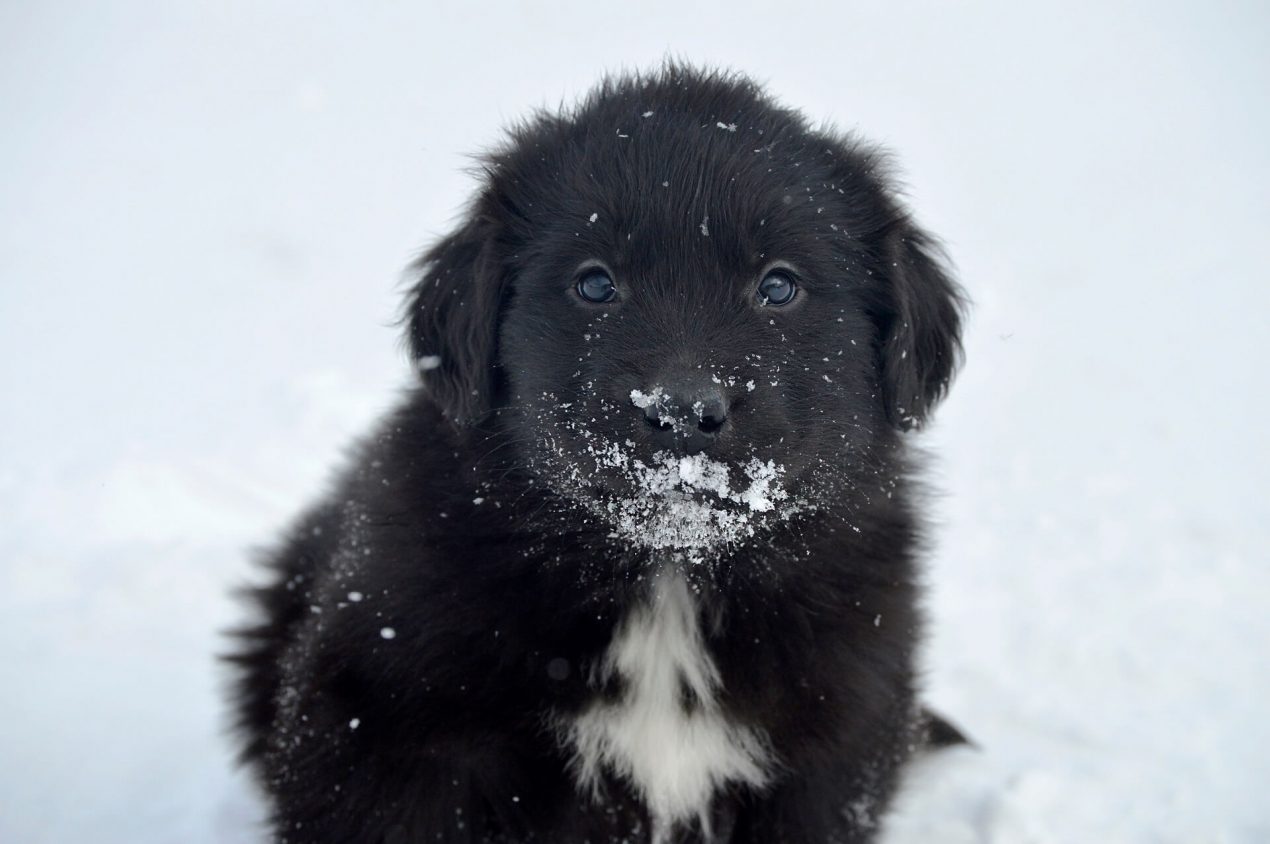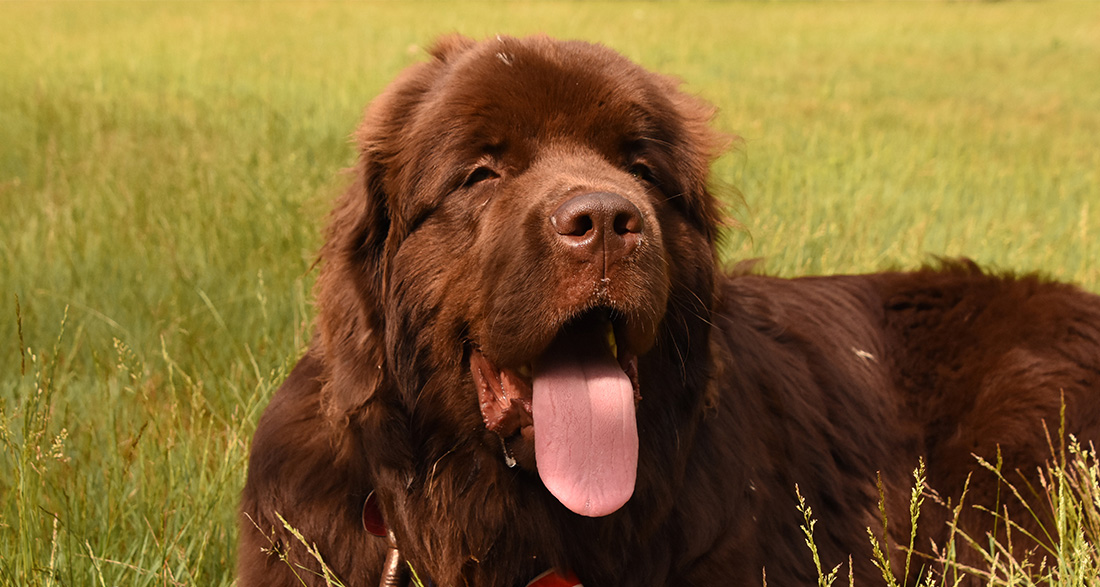The Newfoundland is a very large and powerful breed, but also a true cuddly bear. It loves water and is always in a good mood and friendly. Learn more about what makes this breed special in this profile.
History of the Newfoundland
As the name suggests, the Newfoundland originally comes from the Canadian island of Newfoundland. It developed there from crosses of large local dog breeds, such as the black bear dog introduced by the Vikings from 1100 onwards. European breeds and the dogs of the Micmac and Beothuk Indians also contributed to the breed. The Newfoundland already exhibited essential characteristics at the beginning of the year 1610.
In the 18th century, English Captain Cartwright first mentioned the breed as the “Newfoundland dog.” Fishermen primarily used these large quadrupeds as working animals. The dogs were so connected to the water that they even developed webbed feet.
In 1886, the American Kennel Club officially recognized the breed. In Europe, the breed has become a popular family dog, especially valued for its robustness and affinity for water. Today, Newfoundland is mainly appreciated as a rescue and water dog.
Breed Overview
GROUP: Working
HEIGHT: 26 inches (female), 28 inches (male)
WEIGHT: 100 to 120 pounds (female), 130 to 150 pounds (male)
TEMPERAMENT: Loyal, sweet-tempered, gentle
COAT: Medium-length double coat
COAT COLOR: Black, brown, gray, white and black
HYPOALLERGENIC: No
LIFE SPAN: 9 to 10 years
Temperament and Character
The cuddly and cozy appearance of the Newfoundland perfectly reflects its friendly and laid-back nature. It is considered one of the most gentle dogs and remains unruffled by anything. Nevertheless, it can distinguish well between friend and foe and protect its family from danger if necessary. In the face of threats, the otherwise leisurely dog can react quickly and, for example, save its owner from drowning. Its quiet but determined demeanor appears majestic and can intimidate intruders. The Newfoundland is strongly attached to its family and loves children above all. It gets along well with other pets, including cats.
| Affection Level | High |
| Friendliness | High |
| Kid-Friendly | High |
| Pet-Friendly | High |
| Exercise Needs | Medium |
| Playfulness | Medium |
| Energy Level | Medium |
| Trainability | Medium |
| Intelligence | High |
| Tendency to Bark | Low |
| Amount of Shedding | Medium |

Not only the puppies exhibit an extremely pronounced play instinct and a desire to be everywhere and always. Sometimes, the Newfoundland can be stubborn and try to assert its own interests. Especially when it sees water, the big dog can quickly become impulsive and spirited. With the right training and enough persuasion, you can easily manage its exuberance.
Acquiring a Newfoundland
What to Consider When Buying?
Before getting an adorable Newfoundland puppy, you should be aware that the small dog will quickly become a huge animal. Keeping a Newfoundland in a small city apartment is almost impossible. It needs space, sheds a lot of hair, and drools. If you are sure that the Newfoundland is the right dog for you and you can meet its needs, look for a reputable breeder.
Prices for a healthy and purebred puppy range from $1200 to $1400. From the breeder, you can choose between black, brown, and black-and-white puppies. Of course, you can also find Newfoundland dogs or mixes in shelters that have outgrown their owners and are now looking for a loving new home.
Puppy Development and Training
Due to its enormous size and strength alone, the Newfoundland needs good and consistent training. Such a large and boisterous dog needs rules and must obey its owner unconditionally. The breed is intelligent and quickly understands what you want from it. Training is therefore usually straightforward, and even dog owners with little experience cannot go wrong with enough consistency.
Occasionally, it may be challenging to motivate the cumbersome dog for exercise. It is best to encourage it playfully and with a lot of patience. Violence and aggression have no place in training the Newfoundland. With a few kind words, extra cuddles, or treats, the affectionate four-legged friend will do almost anything.

How to Care for a Newfoundland?
Activities with the Newfoundland:
Thanks to its good and cheerful nature, the Newfoundland is an ideal family dog that also loves to play with children. It needs a lot of outdoor exercise and is enthusiastic about any kind of activity. It is less suitable as a guard or protection dog due to its gentle nature. However, its absolute favorite activity is swimming and anything related to water. Whether you spray it with a hose in the summer or go on a seaside vacation together – where water is involved, the Newfoundland is happy. Therefore, training as a rescue dog is ideal for the Newfoundland. Here, you can not only keep the large dog well-exercised but also bring great joy to it.
Health and Grooming:
Generally, the Newfoundland is not very prone to illness. The only thing that needs special care is its fluffy, dense coat. It consists of water-resistant undercoat and long topcoat. To prevent the coat from starting to smell or getting severely tangled, you should preferably brush and comb the dog daily. Especially during shedding, the amount of hair the dog loses is almost uncontrollable.
After every walk, the dense coat needs to be freed from stuck leaves, burrs, branches, and other dirt. The Newfoundland appreciates any form of affection and will enjoy these additional cuddles. Due to their enormous size, some Newfoundlands suffer from hip dysplasia and associated arthritis. Especially in puppyhood, you should make sure that the little one avoids stairs and gets not too much exercise.

Interesting Facts
Throughout history, there have been many famous Newfoundlands that served as rescue dogs and saved quite a few people from drowning. According to stories, even the military commander Napoleon was saved from drowning by a Newfoundland named Boatswain. The German composer Richard Wagner was also a real fan of the breed.
His first dog, “Robber,” inspired him to his work “The Flying Dutchman,” and his last dog, “Russ,” was even buried together with the composer in Bayreuth. It received its own inscription with the words: “Here rests and guards Wagner’s Russ.” The Scottish writer J.M. Barrie immortalized his female Newfoundland in the famous children’s book “Peter Pan” with the character “Nana.”
Do you have a Newfoundland or plan to get one soon? Tell me more in the comments!


